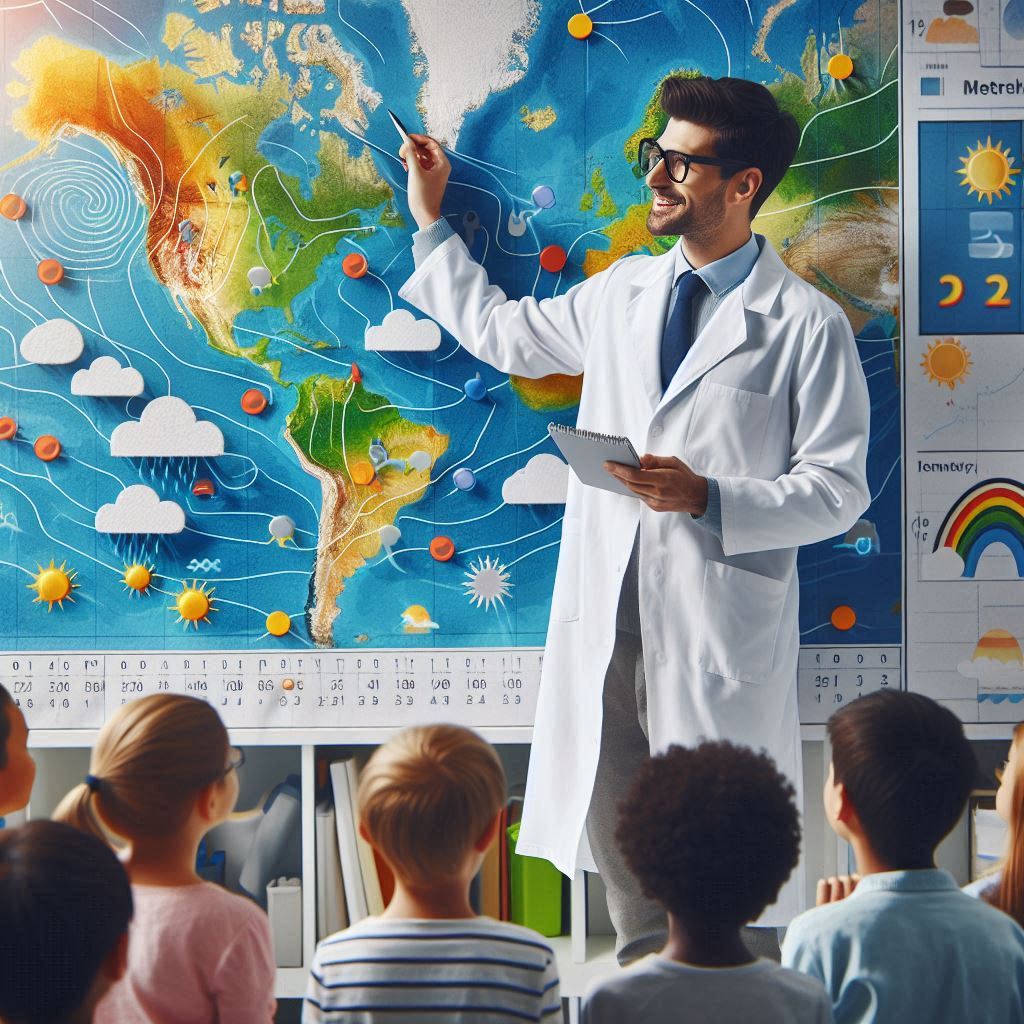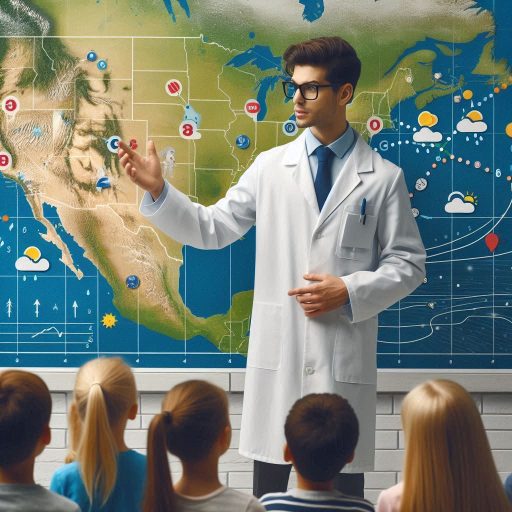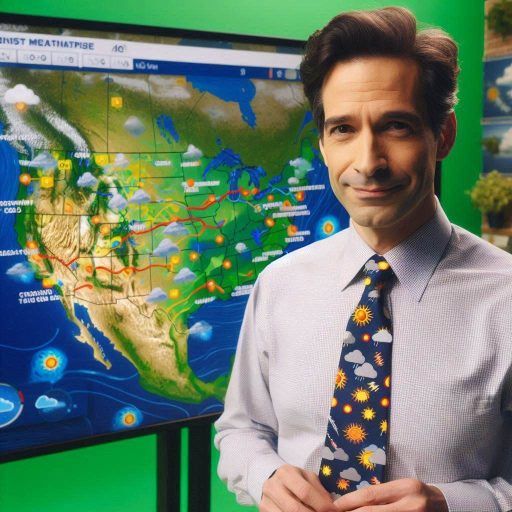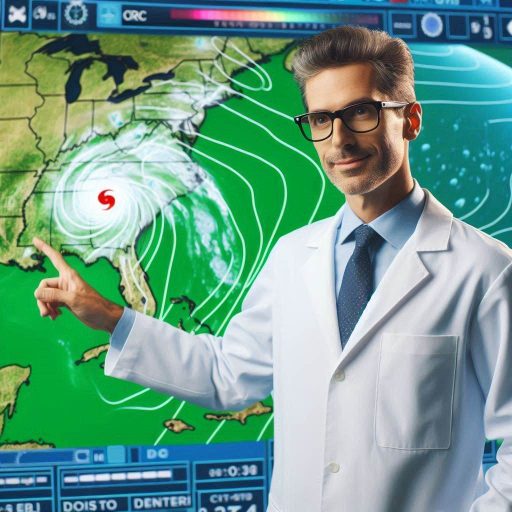Introduction
Meteorologists play a crucial role in our daily lives by studying and predicting weather patterns.
They are the scientists who analyze atmospheric data to understand how different elements interact, allowing them to create accurate weather forecasts.
This involves using a range of tools and technologies, including satellites, radar, and weather stations, to gather data on temperature, humidity, wind speed, and precipitation.
With this information, meteorologists can assess current weather conditions and anticipate how they may change in the near future.
The importance of meteorologists cannot be overstated; their work directly impacts our safety and well-being.
Accurate weather predictions are essential for various sectors, including agriculture, transportation, and emergency management.
Farmers rely on weather forecasts to determine the best times for planting and harvesting crops.
While airlines and transportation companies depend on meteorological data to ensure safe travel.
Additionally, meteorologists provide vital information during severe weather events, such as hurricanes, tornadoes, and floods, helping communities prepare for potential hazards and minimizing risk.
In this blog post, readers can expect to learn about a typical day in the life of a meteorologist.
We will explore the various tasks they undertake, from analyzing complex data to creating detailed forecasts.
You will gain insights into the advanced technology meteorologists use, including computer models and satellite imagery, which help them make informed predictions.
Furthermore, we will discuss how meteorologists communicate their findings to the public, ensuring that people receive timely and accurate information to keep them safe.
Educational Background of a Meteorologist
The Typical Educational Requirements for Becoming a Meteorologist
Becoming a meteorologist typically requires a strong educational foundation.
Most meteorologists hold at least a bachelor’s degree in meteorology or atmospheric science.
Universities offer specialized programs that focus on weather patterns, climate systems, and atmospheric phenomena.
Many institutions also offer master’s degrees and doctoral programs for advanced positions.
The Importance of Coursework in Atmospheric Science and Meteorology
Meteorology programs emphasize a mix of theoretical and practical coursework.
Students learn about atmospheric dynamics, thermodynamics, and hydrometeorology.
These subjects help them understand the processes that drive weather systems.
Additionally, students study meteorological instrumentation and data analysis techniques.
This knowledge equips them to analyze weather data effectively.
Courses in physics, mathematics, and computer science are equally essential.
These subjects build a solid foundation for understanding complex meteorological concepts.
Students gain skills in modeling weather patterns and interpreting atmospheric data.
This educational background prepares them for various roles within the field.
The Significance of Internships and Hands-On Experience in the Field
In addition to classroom learning, hands-on experience is vital.
Internships provide students with practical exposure to the field of meteorology.
Many universities encourage students to seek internships with weather stations, research institutions, or broadcasting companies.
Internships allow students to apply their knowledge in real-world settings.
They also help build valuable professional connections.
During internships, aspiring meteorologists gain practical skills in data collection and analysis.
They learn to operate weather monitoring equipment and interpret weather data.
Interns often assist in preparing forecasts and may even participate in live broadcasts.
This experience is invaluable in understanding the daily responsibilities of a meteorologist.
Networking during internships can open doors to future job opportunities.
Many employers prefer candidates with relevant experience in meteorology.
An internship can lead to a full-time position after graduation or provide references for future job applications.
Therefore, securing an internship is an essential step in a meteorologist‘s career path.
The educational background of a meteorologist is crucial for career success.
A bachelor’s degree in meteorology or atmospheric science lays the foundation.
Coursework in atmospheric science is vital for understanding weather systems.
Additionally, internships provide essential hands-on experience that enhances a graduate’s employability.
Prospective meteorologists should actively seek opportunities to expand their knowledge.
Engaging in relevant coursework and pursuing internships can significantly impact career trajectories.
The combination of academic knowledge and practical experience prepares students for the challenges of meteorology.
This strong foundation ensures that future meteorologists can effectively predict and analyze weather patterns.
Read: The Future of Botany: Emerging Fields and Innovations
Daily Duties and Responsibilities of a Meteorologist
The Typical Tasks That a Meteorologist Performs on a Daily Basis
Meteorologists have diverse daily responsibilities that keep them engaged and informed.
Each day typically begins with reviewing the latest weather data and reports.
They analyze current conditions, including temperature, humidity, and wind patterns.
Meteorologists then prepare forecasts based on their analysis, which can range from short-term predictions to long-term climate outlooks.
In addition to forecasting, meteorologists often communicate their findings.
This communication includes writing reports, creating graphics, and presenting information on television or radio.
They must convey complex data in an easily understandable way for the public.
Engaging with the media and public is a crucial aspect of their role.
Meteorologists also collaborate with other professionals.
They work closely with climatologists, oceanographers, and environmental scientists.
These collaborations enhance their understanding of weather systems and improve forecasting accuracy.
How Meteorologists Collect Data and Analyze Weather Patterns
Data collection is a fundamental part of a meteorologist’s job.
They utilize various sources to gather information, including weather stations, satellites, and radar systems.
Ground-based weather stations provide real-time data on temperature, wind speed, and precipitation.
Satellites monitor larger-scale atmospheric phenomena, while radar systems track storm systems and precipitation.
Once the data is collected, meteorologists analyze it to identify patterns.
They use statistical methods and computer models to interpret the data.
This analysis helps them understand how weather systems interact and evolve.
Meteorologists must stay current with developments in data analysis techniques to improve their forecasting capabilities.
The Use of Technology and Forecasting Tools in Their Work
Technology plays a crucial role in modern meteorology.
Meteorologists rely on advanced software and tools to enhance their forecasting accuracy.
Weather modeling software simulates atmospheric conditions and predicts future weather patterns.
These models use data from various sources, providing meteorologists with valuable insights.
Additionally, meteorologists use Geographic Information Systems (GIS) to visualize weather data.
GIS technology allows them to map out weather patterns, track storm movements, and analyze geographical impacts.
This visualization aids in better understanding and communicating weather forecasts.
Social media has also transformed how meteorologists share information.
Many meteorologists use platforms like Twitter and Facebook to update the public on severe weather events.
This immediate communication helps keep communities informed and safe during extreme weather.
The daily duties and responsibilities of a meteorologist encompass a wide range of tasks.
They analyze data, prepare forecasts, and communicate findings effectively.
Through the use of advanced technology and data analysis techniques, meteorologists continue to improve their forecasting abilities.
Their work is vital in keeping the public informed and prepared for changing weather conditions.
Read: What Does a Geologist Do? Career Overview and Insights
Work Environment of a Meteorologist
Insight Into Where Meteorologists Work
Meteorologists work in various environments, each offering unique experiences and challenges.
Many meteorologists are employed at weather stations, where they monitor atmospheric conditions and gather data.
These stations can be found in remote locations, urban areas, or near airports.
Meteorologists also work for government agencies, such as the National Weather Service (NWS) or the National Oceanic and Atmospheric Administration (NOAA).
These agencies are responsible for monitoring weather patterns and issuing forecasts.
Research institutions and universities also employ meteorologists.
In these settings, they conduct studies on climate change, atmospheric phenomena, and extreme weather events.
Some meteorologists focus on specialized fields, such as marine meteorology or agricultural meteorology.
This diversity in workplace environments allows meteorologists to engage in various aspects of the field.
The Working Hours and Potential for Irregular Schedules
Meteorologists often work standard office hours, but their schedules can vary significantly.
During typical weather patterns, they may work regular hours, including weekdays and weekends.
However, severe weather events require immediate attention.
Meteorologists must be prepared for irregular schedules during storms, hurricanes, or other extreme weather situations.
In these instances, meteorologists may work long hours to monitor conditions and provide timely forecasts.
They often collaborate with emergency responders to ensure public safety.
This means being on call or working nights and weekends when severe weather is imminent.
The unpredictable nature of weather can lead to demanding schedules, but many meteorologists find this aspect of the job rewarding.
The Collaborative Nature of the Job
Collaboration is a key element of a meteorologist’s work environment.
Meteorologists often work alongside other weather experts, such as climatologists, oceanographers, and atmospheric scientists.
This teamwork enhances their understanding of weather systems and improves forecasting accuracy.
Meteorologists also collaborate with emergency responders and public safety officials.
During severe weather events, they provide critical information to help communities prepare.
They work closely with local governments and disaster response teams to ensure timely evacuations and safety measures.
Additionally, meteorologists often engage with the media.
They present weather forecasts and discuss potential impacts on communities.
This collaboration helps inform the public and prepare them for weather-related challenges.
The work environment of a meteorologist is diverse and dynamic.
They operate in various settings, including weather stations, government agencies, and research institutions.
While their working hours can be irregular during severe weather events, many meteorologists thrive in this fast-paced environment.
The collaborative nature of the job allows them to work closely with other experts and emergency responders, ensuring public safety and effective communication during critical situations.
Read: Educational Path: Becoming a Geologist in the USA

Challenges and Rewards of the Job
The Challenges Meteorologists Face
Meteorologists face several challenges in their profession.
One of the primary challenges is the pressure to accurately predict weather events.
Given the potential impact of weather on daily life, any mistakes can have serious consequences.
Meteorologists must provide timely and accurate forecasts to help communities prepare for storms, floods, and other hazards.
This pressure can be stressful, particularly during severe weather situations.
Another challenge is the complexity of weather systems.
Meteorologists must analyze vast amounts of data from multiple sources.
They interpret this information to develop forecasts, which requires a deep understanding of atmospheric science.
The unpredictable nature of weather can make accurate predictions difficult, leading to added pressure.
Additionally, technology plays a crucial role in forecasting.
While advanced tools have improved accuracy, they also require meteorologists to stay current with evolving technologies.
The need to continuously adapt to new software and modeling techniques can be demanding.
The Satisfaction of Successfully Predicting Weather Patterns
Despite the challenges, meteorologists experience immense satisfaction in their work.
Successfully predicting weather patterns and helping communities prepare for potential hazards is deeply rewarding.
When meteorologists accurately forecast a severe storm, they contribute to public safety and well-being.
This sense of accomplishment comes from knowing their work can save lives and protect property.
For instance, timely warnings about hurricanes or tornadoes can help people evacuate or take necessary precautions.
The gratitude expressed by communities during these events reinforces the value of their contributions.
Meteorologists often share their forecasts through various media platforms, including television, radio, and social media.
Positive feedback from viewers can further enhance their job satisfaction.
Knowing that their efforts have made a difference in people‘s lives is a powerful motivator.
The Importance of Continuous Learning and Staying Up-to-Date
Continuous learning is crucial for meteorologists to thrive in their careers.
The field of meteorology is constantly evolving, with new research and technology emerging regularly.
Meteorologists must stay informed about the latest developments in weather prediction models, satellite technology, and climate science.
Many meteorologists participate in ongoing education and training programs.
They attend conferences, workshops, and seminars to expand their knowledge and skills.
Engaging with peers and experts in the field fosters professional growth and encourages collaboration.
Moreover, understanding the impact of climate change on weather patterns is increasingly important.
Meteorologists need to adapt their forecasting methods to account for these changes.
This ongoing education allows them to provide more accurate and relevant forecasts.
The job of a meteorologist comes with its challenges and rewards.
They face pressure to deliver accurate predictions while navigating complex weather systems.
However, the satisfaction of successfully forecasting severe weather and protecting communities is immensely fulfilling.
Continuous learning is vital for staying current in this ever-evolving field, ensuring that meteorologists remain effective in their roles.
Read: Botany Career Fairs and Networking Events
Uncover the Details: Impact of Virologists on Global Health Initiatives
Impact on Society
How Meteorologists Play a Crucial Role in Public Safety and Disaster Preparedness
Meteorologists play a vital role in ensuring public safety and disaster preparedness.
Their expertise helps communities prepare for severe weather events such as hurricanes, tornadoes, and blizzards.
By providing timely and accurate forecasts, meteorologists inform the public about potential hazards and necessary precautions.
When severe weather is imminent, meteorologists work closely with government agencies and emergency responders.
They help coordinate disaster preparedness efforts, ensuring that communities are ready for any situation.
This collaboration allows for efficient evacuation plans and resource allocation during emergencies.
Meteorologists also educate the public about weather phenomena.
Through outreach programs, they teach people how to interpret weather alerts and warnings.
This education empowers communities to take appropriate actions, ultimately saving lives and minimizing property damage.
The Significance of Accurate Weather Forecasts in Informing Decision-Making
Accurate weather forecasts significantly impact decision-making for individuals, businesses, and government agencies.
For individuals, timely forecasts influence daily choices, such as travel plans and outdoor activities.
Knowing when severe weather is expected allows families to prepare accordingly.
Businesses also rely on accurate weather predictions to make informed decisions.
Industries such as agriculture, transportation, and tourism are particularly affected by weather conditions.
For example, farmers depend on forecasts to determine optimal planting and harvesting times.
Airlines and shipping companies use weather information to plan safe routes and schedules.
Government agencies rely on meteorologists for disaster planning and response.
Accurate forecasts help officials allocate resources, issue warnings, and implement emergency plans.
The information provided by meteorologists can influence policy decisions related to infrastructure and public safety.
Transform Your Career Today
Unlock a personalized career strategy that drives real results. Get tailored advice and a roadmap designed just for you.
Start NowThe Responsibility That Meteorologists Have in Communicating Weather Information
Meteorologists bear a significant responsibility in communicating weather information to the public effectively.
Their forecasts must be clear, concise, and accessible to diverse audiences.
Meteorologists must present complex data in a way that everyone can understand, regardless of their level of expertise.
During severe weather events, effective communication becomes even more critical.
Meteorologists often use multiple platforms, such as television, radio, and social media, to reach a broad audience.
This multi-channel approach ensures that vital information reaches those who need it most.
Additionally, meteorologists must be transparent about the uncertainties inherent in weather forecasting.
They should communicate the likelihood of different weather outcomes and explain the reasoning behind their predictions.
This transparency helps build trust with the public, enabling communities to make informed decisions.
Meteorologists have a profound impact on society.
Their role in public safety and disaster preparedness is essential, as they provide critical information during emergencies.
Accurate weather forecasts inform decision-making across various sectors, helping individuals and organizations respond effectively to changing conditions.
Furthermore, the responsibility of effectively communicating weather information underscores the importance of their work in safeguarding communities.
Career Advancement Opportunities for Meteorologists
The Potential for Meteorologists to Specialize in Specific Areas
Meteorologists have numerous opportunities to specialize in specific areas within the field.
This specialization allows them to focus on their interests and contribute to various sectors.
For example, meteorologists may choose to specialize in climate research, studying long-term weather patterns and their implications for global change.
This specialization can lead to significant contributions in areas like environmental policy and sustainability.
Another area of specialization is severe weather forecasting.
Meteorologists in this field focus on predicting extreme weather events such as hurricanes, tornadoes, and thunderstorms.
They use advanced models and technologies to assess risks and enhance public safety.
These specialists often collaborate with emergency management agencies to improve preparedness and response efforts.
Broadcast meteorology is another exciting avenue.
Meteorologists in this field present weather forecasts on television and digital platforms, requiring strong communication skills.
They engage with the public while interpreting complex data and delivering crucial information during severe weather events.
Specializing in this area allows meteorologists to combine their technical expertise with a passion for public outreach.
Opportunities for Professional Development and Continuing Education
Continuous professional development is essential for meteorologists to stay relevant in their field.
Various organizations offer workshops, seminars, and conferences that provide networking opportunities and the latest research findings.
Participating in these events helps meteorologists stay updated on advancements in technology and meteorological techniques.
Additionally, many meteorologists pursue continuing education courses to enhance their skills.
These courses may cover topics such as climate modeling, data analysis, or communication strategies.
Online platforms and universities often offer these educational opportunities, making them accessible to professionals at various stages of their careers.
Certifications, such as the American Meteorological Society (AMS) Certified Broadcast Meteorologist (CBM) or AMS Certified Consulting Meteorologist (CCM), can also enhance career prospects.
Earning these credentials demonstrates expertise and commitment to the profession, making meteorologists more competitive in the job market.
Potential Career Paths for Experienced Meteorologists
Experienced meteorologists have various career paths to consider, depending on their interests and expertise.
One common advancement opportunity is becoming a chief meteorologist.
In this role, they oversee weather teams, manage forecasting operations, and ensure the accuracy of public communications.
Chief meteorologists play a critical role in shaping their organization’s weather coverage and public outreach strategies.
Another potential path is transitioning into academia.
Meteorologists who pursue advanced degrees may choose to teach at universities or conduct research in atmospheric science.
This career path allows them to contribute to education while influencing the next generation of meteorologists.
Some meteorologists may also transition into consulting roles.
In this capacity, they provide expert advice to businesses, government agencies, and organizations on weather-related issues.
This could involve risk assessment for weather impacts, climate change consulting, or developing weather strategies for specific industries.
Meteorologists enjoy numerous career advancement opportunities within their field.
Specialization allows them to focus on areas such as climate research, severe weather forecasting, or broadcast meteorology.
Continuous education and professional development enhance their skills and knowledge.
Additionally, experienced meteorologists can explore career paths as chief meteorologists, educators in academia, or consultants, furthering their impact on society.
See Related Content: Anthropology vs. Sociology: Key Differences
Uncover the Details: Neuroscience Internships: How to Get Started
Find Out More: Impact of Neuroscience on Mental Health Studies
Conclusion
A day in the life of a meteorologist is both dynamic and multifaceted.
Meteorologists analyze data from various sources, create forecasts, and communicate critical weather information effectively to the public.
They are on the front lines of predicting weather conditions, helping communities prepare for storms, heatwaves, and other severe weather events.
Their expertise is vital in keeping people safe and informed about changing weather patterns.
Throughout their day, meteorologists collaborate with various agencies, including the National Weather Service, to ensure accurate and timely information dissemination.
They use advanced technology, such as radar and satellite imagery, to enhance their predictions and provide up-to-date analyses.
This profession requires strong analytical skills, attention to detail, and a genuine passion for science and weather.
For those intrigued by the atmosphere and its impact on daily life, meteorology offers a rewarding career path filled with opportunities for growth and learning.
It allows individuals to contribute significantly to public safety and environmental awareness.
By understanding the intricacies of this field, one can appreciate its importance even more.
I encourage readers to explore meteorology further, as it plays a crucial role in our lives.
Whether through educational resources, internships, or volunteering, there are many ways to engage with this fascinating discipline.
Embrace the chance to make a difference in your community through this vital profession.
A career in meteorology not only satisfies curiosity about weather phenomena but also enables you to impact society positively.
[E-Books for Sale]
The Big Book of 500 High-Paying Jobs in America: Unlock Your Earning Potential
$19.99 • 500 High-Paying Jobs • 330 pages
Explore 500 high-paying jobs in America and learn how to boost your career, earn more, and achieve success!
See All 500 High-Paying Jobs of this E-Book
1001 Professions Without a Degree: High-Paying American Jobs You Can Start Now
$19.99 • 1001 Professions Without a Degree • 174 pages
Discover 1001 high-paying jobs without a degree! Unlock career tips, skills, and success strategies for just $19.99!




